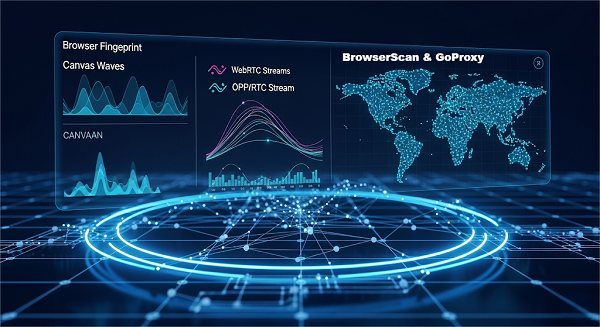Guide to Buying AI Training Data: Evaluation & 2025 Top Providers
Learn how to evaluate and buy AI training data with checklists, 205 top providers, ethical tips, and 2026 trends.
Dec 19, 2025
Step-by-step BrowserScan tutorial with GoProxy: set up proxies, test leaks, optimize fingerprint score, automate audits, and maintain anonymity.
BrowserScan gives a live authenticity score to spot every weak link, whether for a security analyst distinguishing real users from bots, or a privacy buff hunting down WebRTC leaks. This step-by-step guide shows you how to pair BrowserScan with GoProxy proxies to eliminate DNS/WebRTC leaks, boost your fingerprint score above 95%, automate daily audits, and stay anonymous online.
Browser fingerprinting is a method websites use to identify you by collecting unique details about your browser and device. Think of it like a digital ID card—formed from data such as your browser version, operating system, screen size, and even the fonts you’ve installed. Unlike cookies, which you can clear, fingerprints stick around, making them a stealthy way to track you across the web. For users, this can mean unwanted ads, profiling, or worse—compromised privacy.
| Scenario | Concern | How BrowserScan Helps |
| Privacy Seekers | Canvas or WebRTC leaks | Detects and pinpoints leak sources |
| Fraud Analyst | Headless/browser automation fraud | Flags inconsistencies in entropy signals |
| Web Scraper | Captchas, IP bans, geo-mismatch errors | Verifies proxy masking and fingerprint integrity |
BrowserScan gathers high-entropy signals—browser version, OS, screen resolution, Canvas/WebGL outputs, DNS & WebRTC leaks—and calculates an authenticity score (0–100%). Scores below 90% highlight vulnerabilities.

Further Reading: For core features and basic principles, see “How to Use BrowserScan to Verify Your Browser Fingerprint”.
Log into your GoProxy dashboard. Choose a proxy in your target region (e.g., United States → New York).
Chrome/Edge:
Settings → System → Open proxy settings. In LAN Settings, enable “Use a proxy server” and enter GoProxy host/port.
Firefox:
Options → Network Settings → Manual proxy configuration. Enter GoProxy host/port for HTTP(S).
Editor’s Tip: Enable “Use proxy for DNS” to prevent DNS leaks.
1. Visit BrowserScan in your proxied browser session.
2. Run All Tests and note:
IP & Geolocation: Should match your selected proxy region.
DNS & WebRTC: Both should report only the proxy IP.
Canvas & WebGL: Capture your device fingerprint.
3. Interpret Results
| Metric | Ideal Result | Action if Fails |
| IP Match | ✔ Same as GoProxy endpoint | Check proxy credentials or region selection |
| DNS Leak | ✔ No local DNS shown | Enable proxy DNS or install DNS-over-HTTPS |
| WebRTC Leak | ✔ No local IP detected | Add a WebRTC-block extension |
| Canvas & WebGL | ✔ Consistent with prior runs | Switch or reconfigure Canvas-noise extension |
| Authenticity ≥ 95 | ✔ High match for typical user fingerprint | See Step 3 |
| IP Mismatch | ✖︎ — | Verify you’re routing through GoProxy properly |
Disable Uncommon Plugins/Extensions: Remove rarely used add-ons that raise entropy.
Match Screen Resolution: Manually set your display to common sizes (e.g., 1920×1080).
Canvas-Noise: Injects slight randomness into Canvas rendering.
Header Modifiers: Align User-Agent and Accept-Language to your region.
Until your authenticity score stabilizes above 95%.
Automate daily checks to catch drifts in your setup.
python
import requests, csv, datetime
API_URL = "https://api.browserscan.example/v1/check"
PROXY = {
"http": "http://user:[email protected]:port",
"https": "http://user:[email protected]:port"
}
response = requests.get(API_URL, proxies=PROXY).json()
score = response["authenticity_score"]
timestamp = datetime.datetime.utcnow().isoformat()
with open("fingerprint_log.csv", "a", newline="") as f:
writer = csv.writer(f)
writer.writerow([timestamp, score])
print(f"[{timestamp}] Score: {score}%")
yaml
name: Daily BrowserScan Audit
on:
schedule:
- cron: '0 2 * * *' # 02:00 UTC daily
jobs:
audit:
runs-on: ubuntu-latest
steps:
- uses: actions/checkout@v3
- name: Run audit script
run: python3 scripts/audit.py
- name: Commit logs
run: |
git config user.name "github-actions"
git config user.email "[email protected]"
git add fingerprint_log.csv
git commit -m "Daily audit $(date +'%Y-%m-%d')"
git push
Note: Store your proxy credentials as encrypted secrets in GitHub.
| Symptom | Possible Cause | Fix |
| DNS still shows local server | Browser ignoring proxy for DNS | Force “Use proxy for DNS” or install a DoH extension |
| Time zone mismatch | Proxy region/timezone not aligned | Choose a proxy in the matching timezone |
| Canvas anomalies persist | Spoof extension misconfigured | Reinstall or switch Canvas-noise extension |
| IP mismatch | Proxy routing failure | Verify browser proxy settings or restart the client |
| Captchas despite high score | Behavior still looks automated | Introduce random mouse movements and delays; throttle requests (1–3 s) |
1. Set Up Cron Jobs on your local server or CI pipeline (see Step 4).
2. Alert on Score Drops: Integrate with Slack or email (using a simple webhook) to notify if score < 90%.
3. Trend Analysis: Use a spreadsheet or BI tool to chart weekly score averages and identify patterns.
Daily for active scraping operations; weekly for casual privacy checks.
Yes—just configure your mobile proxy in Step 1 and verify its geolocation in Step 2.
Most BrowserScan APIs allow 1,000 requests/day. Contact support for higher quotas.
Try a Free Fingerprint Test: Visit BrowserScan now.
Explore GoProxy Plans: Unlock rotating residential IPs in 200+ regions and countries. Unlimited traffic rotating residential proxy plans for your scale needs.
Take charge of your digital footprint today—run BrowserScan with GoProxyt and see the difference!
< Previous
Next >
 Cancel anytime
Cancel anytime No credit card required
No credit card required